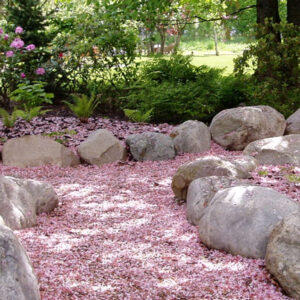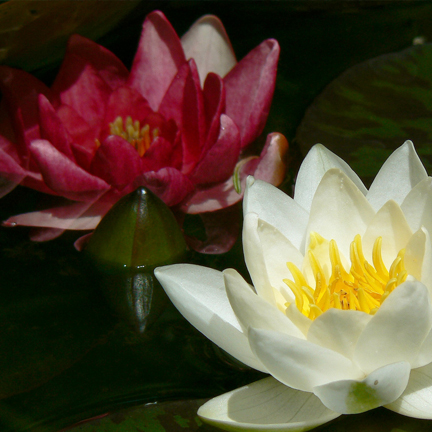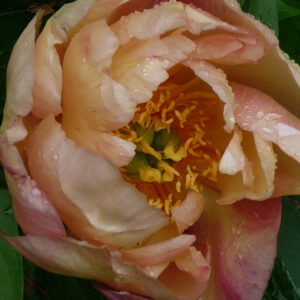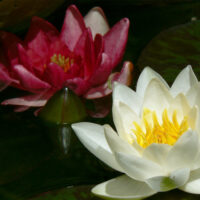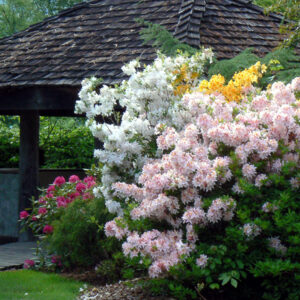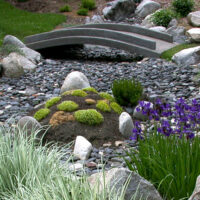GARDEN HISTORY

From the start of a dream, an enormous amount of work has gone into the Kohan Reflection Garden. The Garden has hosted dance, music, theatre, poetry readings, book signings, martial arts, yoga and art classes. There have been celebrations of birthdays, weddings and memorials for those who have passed. Visitors include the local community, families camping in Centennial Park, folks from nearby towns and cities, tours of people of Japanese heritage and survivors of other internment camps.
We are grateful to all those who have contributed in any way to creating this beautiful and valuable community asset.
The following is a brief history and timeline of the Garden’s beginnings, expansions and exciting events:
ORIGINAL TEAHOUSE
This structure was built as an outdoor meeting place by the Japanese-Canadian community.
JAPANESE FLOWERING CHERRY TREES
These are the original trees planted by the Funjinkai Society after WWII, as a gift to the community, and only these two venerable trees remain in the Village today.
1989 THE FIRST JAPANESE MAPLE TREE PLANTED IN THE KOHAN
This Acer palmatum atropurpureum, donated by Chie Kamegaya, is only one of over 1,000 varieties of Japanese maple. Cultivated for centuries in Japan, they are cherished for their brilliant seasonal colour and shapely, elegant form in winter.
1990 ENTRANCE GATE
The Entrance Gate is a place of sanctuary and transition where one leaves the outer world and moves to an inner space of peace and tranquility. It indicates to the visitor that they are entering a special place. This building houses a dedication plaque which gives a brief history of Japanese-Canadians in our area.
1990 – 1991 LARGE POND PROJECT
Volunteers with shovels and machines excavate and build the rockwork for what became one of the Garden’s most popular features, a three-tiered recirculating pond.
1992 GRAND OPENING
The Kohan Reflection Garden officially opens! Plantings are new and the ground is a bit rough but the vision is growing.
1992 – 1993 BUILDING THE WALL
A garden wall acts as a barrier or screen but it can also delineate different areas with different moods. It can mark a transition from one spiritual space to another. This plastered wall suggests a traditional “neribei” and separates the Teahouse from the next garden room.
1992 – 1993 REMOVING THE T.V. TOWER
There was a fair bit of community controversy about relocating the T.V. tower. No one wanted it moved into their neighbourhood or sight line but it was definitely difficult to incorporate it into the aesthetics of the Garden. A helicopter and giant crane were needed for moving the structure to its new home.
2000 KOHAN REFLECTION GARDEN WATERFRONT ENHANCEMENT PROJECT
Funding, provided by the B.C. government through the Community Spirit Grant, enabled the Society to mark the millennium by landscaping the south end of the Kohan. Landscape interest includes the grasses beds, arched bridge, and the dry stream bed. The T.V. tower foundation became a raised lily pond.
2001 THE WORKERS GATE
2001 – 2002 TEAHOUSE RENOVATION
New floor, new cedar shakes and new paint.
2002 NEW KOHAN REFLECTION GARDEN SIGN
2003 ISHI-DORO LANTERN
Pauli Inose’s contributions to the Garden are commemorated by the “ishi-doro” stone lantern. In a Japanese garden, besides providing light for a turn in a path, by a pond, in shaded areas, a lantern also lends light to spiritual darkness.
2008 NEW IRRIGATION SYSTEM
One of the hardest jobs in the summer is to keep the garden watered and green. Thanks to six provincial and regional funding sources, the Garden has an automatic irrigation system.
2009 20TH ANNIVERSARY
Arts, Dance and Music
A pedestal lantern was donated to the Kohan Garden by the Village of New Denver for the 20th anniversary.
2011 – 2012 SECURE THE SHORE
A storm with hurricane-force winds swept up the lake and toppled scores of trees in the region. The Kohan Garden suffered the loss of several giant black poplars which, as they fell, tore up the shoreline banks and an access path between two lawns. To read about our restoration project, click here.
2012 TSUKUBAI
The tsukubai is the arrangement of stones, plants and a chōzubachi basin where, as an act of humility and spiritual cleansing, one bends to wash before entering the Teahouse.
2012 ARTS IN THE KOHAN
Artists, musicians and artisans were invited to use the Kohan Garden as a one-day venue to display and sell their work. Participants worked at their arts as visitors strolled the pathways. This event was co-sponsored by the Slocan Lake Gallery Society (currently, Slocan Lake Arts Council).
2014 NIKKEI INTERNMENT MEMORIAL CENTER 20TH ANNIVERSARY
In partnership with the Nikkei Center, SLGS hosted music, performance and Japanese arts in the Kohan Garden.
2015 25TH ANNIVERSARY
An anniversary is always a great occasion to showcase the Garden. Volunteers worked hard to spruce up the garden beds while the Board of Directors invited performers and artists to perform, entertain and feed numerous visitors on the one-day celebration.
2015 IRRIGATION EXTENSION AND SERVICE AREA LANDSCAPING
2017 REPAIRS AND IMPROVEMENTS
Two new stone walkways were installed.
Ongoing maintenance is always needed in the Garden and in 2017 the Entrance Gate shake roof was replaced.
2018 THE TSURIGANE
Ceremonial bell is added to the Garden, situated just inside the Entrance Gate.
ONWARD
A garden is never finished. Plants are replaced as they overgrow their allotted space or succumb to disease and weather. Beds are renovated for a fresh look. Infrastructure needs repair and maintenance is an ongoing task. All these factors require the Society’s resources, but it is obvious that the community’s financial support and volunteers’ work have successfully nurtured this lovely garden for over 30 years.

